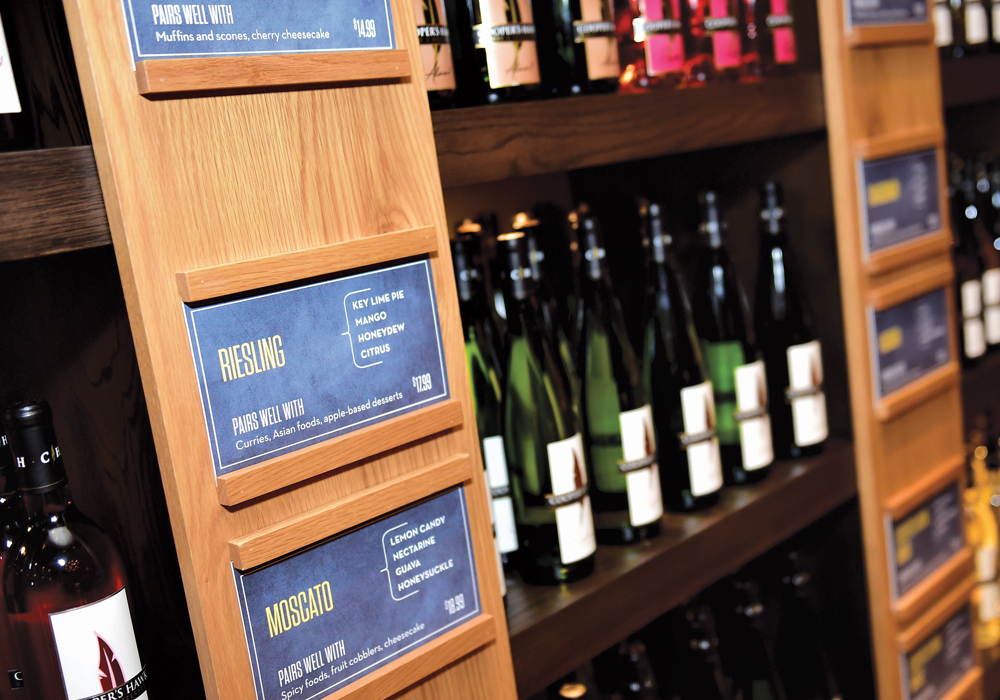Think Pink . . . And 0range
During spring and summer, guests often straddle white and red and drink rosé and to lesser extent, orange wines. “Rosé and orange wines are a natural fit for spring and summer,” notes Robert Rodriguez, general manager for Cured resaurant in San Antonio, TX.
Cured pairs its pan-seared redfish with tomatillo chow chow and hominy puree ($27) with Le Charmel Côtes de Provence rosé ($38 a bottle), which highlights the corn’s earthiness and matches the chow chow’s pungent sharpness.
At Fleming’s Prime Steakhouse & Wine Bar, national wine director Maeve Pesquera recommends the Miraval Estate rosé ($68 a bottle), produced on the Provence winery of Angelina Jolie and Brad Pitt in partnership with the Perrin family.
Italy doesn’t have much of a rosé tradition, notes David Kurka, general manager/beverage director for Masseria in Washington, D.C. But there are great ones coming out of Puglia, like the 2015 Tormaresca Negroamaro rosé ($50). “It’s light and fruity, but still dry.”
As for orange wines, which are made by macerating white grapes on their skins, most somms think they still have a way to go before guests gravitate toward them—or even know they exist. These wine are interesting, but they aren’t getting much attention from wine drinkers, says Rob Warren, director of winemaking for Cooper’s Hawk Winery & Restaurants.
Warren’s beer comparison may make the wines a bit easier for guests to understand, though. “Orange wines are kind of like the ‘lambic beer’ version of wine: sour, bitter and nutty.”

Acid Trips
Wine pairings are generally either that of complementing or contrasting, Rodriguez says. “Often the cooking technique is even more important to consider than the actual ingredients, such as pickling, fermenting or preserving.”
Cured foie gras with hog tongue, strawberry jam and green strawberries ($16) is a rich yet tart dish. Abbazia di Novacella Kerner ($51 a bottle) from an indigenous red varietal in Alto Adige, Italy, works both by contrasting the acidity of the pickled green strawberries, and by complementing the sweet notes in the foie gras and the red berries.
Wagyu beef tartare with mezcal, chipotle, egg emulsion and toasted brioche ($14) works with Kuhlman Cellars viognier ($64 a bottle) from Stonewall, TX. “Elderflower, banana and pineapple notes match the aromatic garnish of spring flowers on this dish,” explains Rodriguez. “Bright acid cleanses the palate of chipotle spice and egg emulsion richness.”
Italian wines are legendary for their ability to seamlessly work with—rather than overshadow—cuisine, and that goes for spring fare. David Kurka, general manager/beverage director for the 60-seat Puglia cuisine-focused restaurant Masseria in Washington, D.C., turns to crisp whites from northern Italy’s Alto Adige region for the chef’s a la carte and prix fixe menus. One is the 2014 Alois Lageder pinot bianco “Haberie” ($60 a bottle.)
“Also, Friuli is a good source for fruity, but not over-the-top sauvignon blancs,” he notes, including the 2014 Russiz Superiore sauvignon blanc ($70 a bottle.)
A chilled, frizzante 2015 Braida “La Monella” Barbera ($60 a bottle) from Piedmont works well as an aperitif or with light antipasti and salumi. Masseria has 21 wines by the glass and 300 by the bottle.
When it comes to pairing, Kurka is based more on intuition rather than science. He considers the ingredients of the dish and how it’s prepared, any components that might clash or throw a wrench into a conventional pairing—like red wine sauce on fish.
“I imagine what I would want to drink with the dish,” he explains. “So basically, when you are doing the wine pairings at Masseria, it’s like my greatest hits.”
Kurka pairs piccone, squab, English peas and sour cherries (part of Masseria’s prix fixe menu, which ranges from $64 to $85 depending on number of courses) with the 2011 Nerello Mascalese Tenuta Aglaea. The wine, which he prices at $120 a bottle, is grown in volcanic ash soil in Italy’s trendy Mt. Etna region on Sicily.
“It is truly unique, with light color and layers of ashy, smoky minerality,” Kurka says of the Nerello Mascalese. “It is not fruit-driven, but it does have pretty, just-ripe, fresh cherry aromas.”
He compares it to Burgundy meets the Northern Rhône by way to Sicily. The wine’s tannins are softened by the meatiness of the squab, while the sour cherries match those in the glass.
And what about asparagus, thought to be a wine killer? Kurka partners up giant white asparagus, bottarga and sorrels with the 2013 Gini Soave Classico “La Frosca” ($80 a bottle), a single-vineyard, garganega-based wine from the Veneto.
The pronounced minerality heightens the lemon and almond and the salty cured bottarga, he notes, while the seared asparagus is akin to the wine’s toastiness, and the mouthwatering acidity keeps you wanting more.
Kelly Magyarics, DWS, is a wine, spirits and lifestyle writer and wine educator, in the Washington, D.C. area.
Pictured atop: Fleming’s Prime Steakhouse & Wine Bar offers 100 wines by the glass or bottle.



